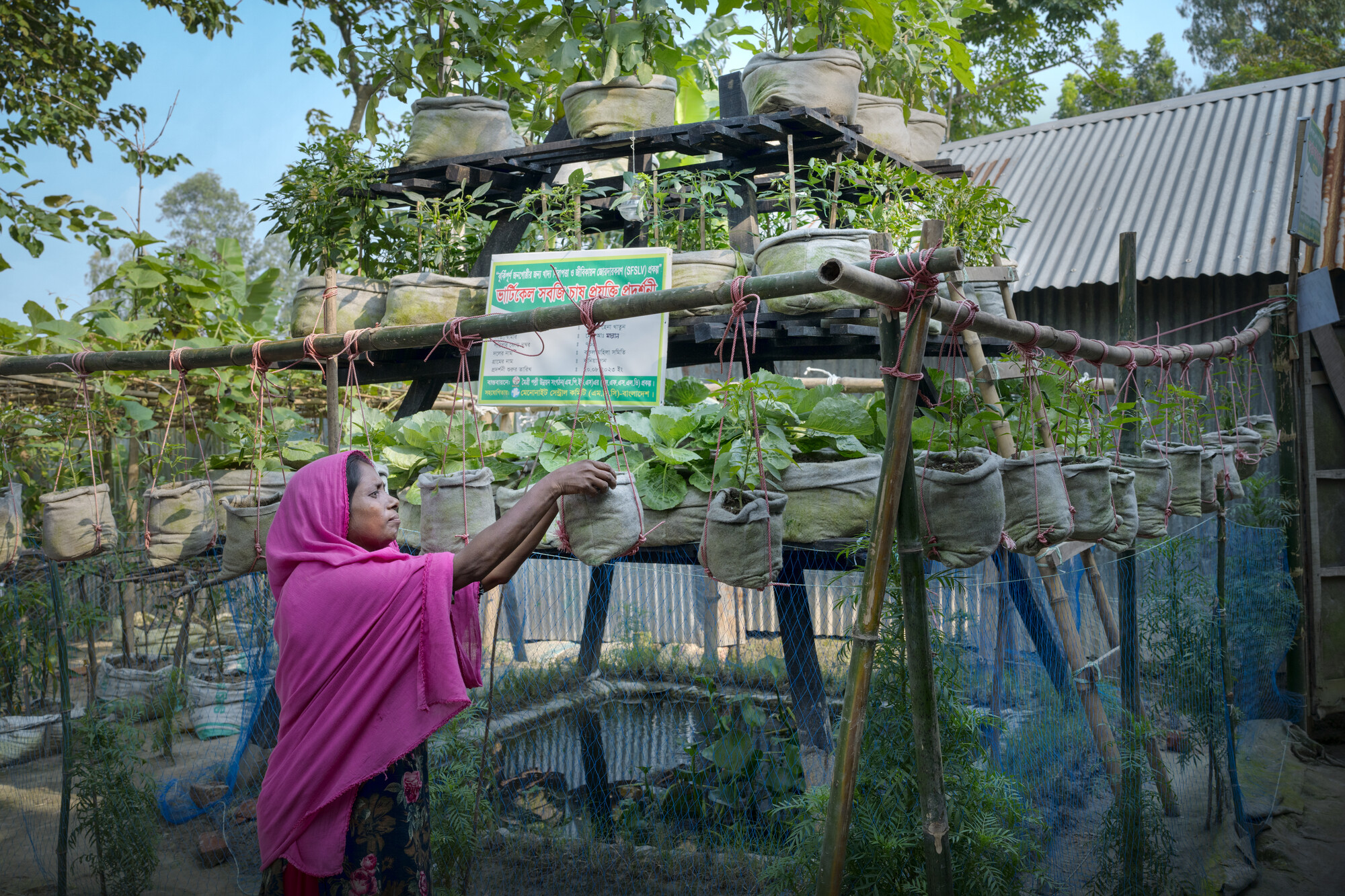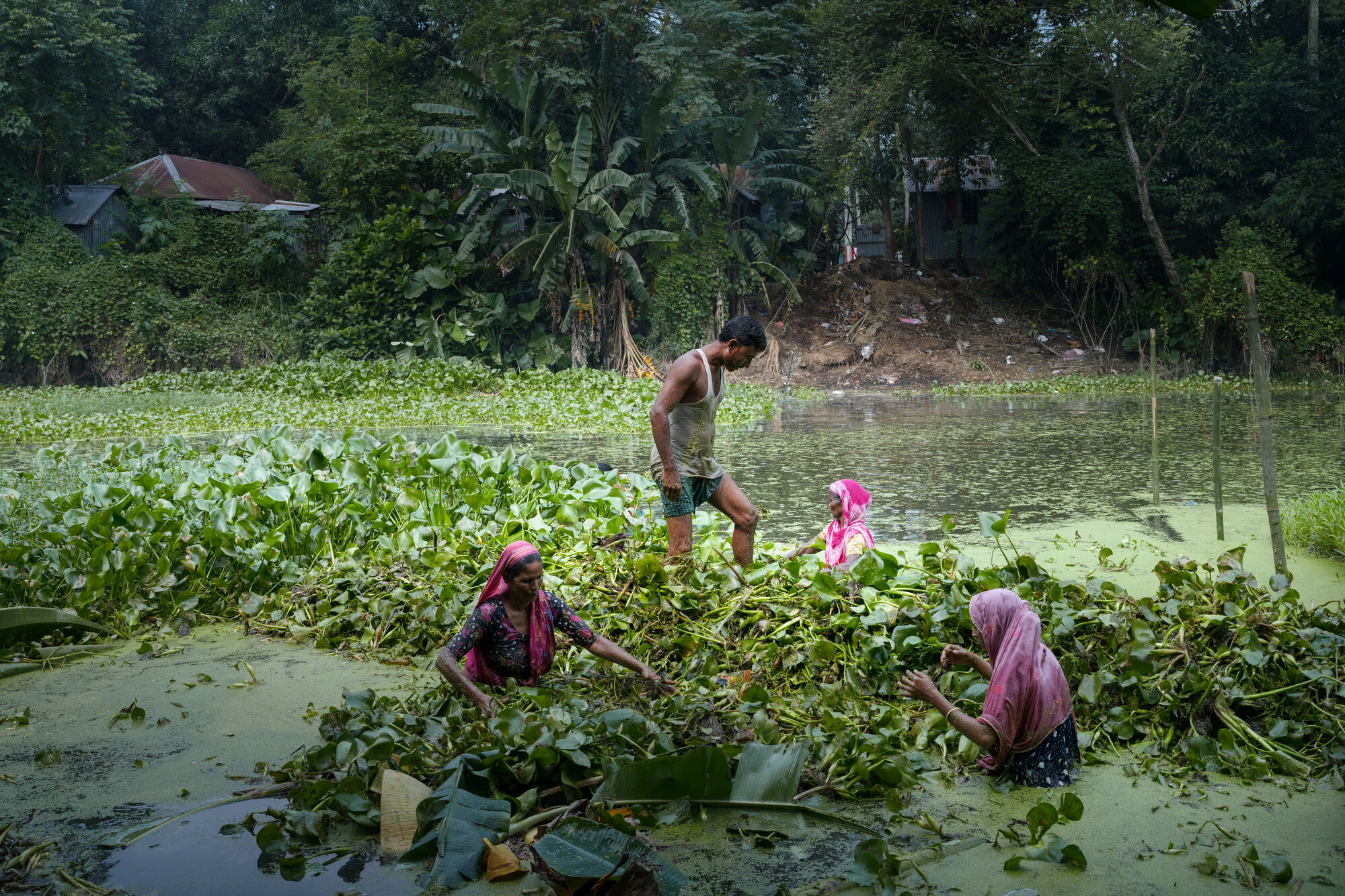Above the floodwaters
With guidance from an MCC partner, gardeners with small plots along a Bangladesh river are looking up.
Hena Khatun has a courtyard full of reasons to believe that she will be able to feed and care for her daughter and sickly husband, despite the floodwater from the nearby Jamuna River that threatens to cover the land where she lives.
Every rainy season in Bangladesh, usually between June and September, the Jamuna — one of the world’s largest braided rivers — floods several times. Sometimes the floodwater just threatens to enter her courtyard, but at the worst of times it crosses the courtyard, climbs the stairs and covers the concrete floor of the tin house where she’s lived for 11 years. She, like most in the area, can’t afford housing or land further away from the river.
Until the 2023 rainy season, Khatun didn’t even try to plant vegetables on her postage-stamp-size property 30 miles from the city of Bogura, in northwest Bangladesh. Flooding aside, she figured her 870-square-foot courtyard was too small to grow much of anything anyway.
Then, staff from MCC partner Maitree Palli Unnayan Sangathon (MPUS) taught her to look up. The local NGO showed her techniques they’d learned from MCC’s agricultural team in Bangladesh.
Now Khatun has eggplant, chiles and cabbage growing in sacks that sit on the ascending shelves of an 8-foot-tall, triangular bamboo structure, called a 3D garden. More eggplant grows in hanging bags, which are out of reach of rising water and can be moved if necessary. Bottle gourds, a favorite ingredient in Bengali cooking, grow on vines that spread across a bamboo canopy.

Families can even take measures to prevent their animals from being washed away. Ducks, which MPUS provided, are the poultry of choice because they can swim in their enclosure if the water rises. A raised platform built inside Khatun’s simple shed creates a second floor, so the female goat that MPUS gave her has a safe refuge from rising water.
“I am proud about this garden,” Khatun says. She points out a lemon tree. “Earlier, I used to buy lemons from the market, but now I don’t need to buy them.” So far, she is cooking what is growing, but as the garden matures and her skills improve, she hopes to sell extra produce.
“Other women, they are very impressed to see my garden,” Khatun says. “They also are learning. They never saw vegetables growing in sacks. So, they are also very happy and interested.”
Curious neighbors are exactly what MPUS hoped for when they helped Khatun transform her empty courtyard into a demonstration plot, called a climate-smart house. If neighbors see the new ideas working for Khatun, they are more likely to try the methods themselves.

Learning to grow food in a small area is critical for the health of the families living along the river, many of whom are malnourished, says Arefur Rahaman, food security and livelihoods coordinator for MCC in Bangladesh. And the need for flood-resilient gardens will keep growing as climate change continues.
According to Rahaman, in the past three years, the frequency of flooding has increased because of climate change. “It was once or twice a year, but now it is happening four or five times in a year,” he says, citing data and farmers’ observations. Floods used to come only during the rainy season, but in 2023, some properties were flooded in October as winter crops were being planted.
"[Flooding] was once or twice a year, but now it is happening four or five times in a year."
In response, MPUS holds weekly yard meetings for women — organized into 36 groups of 20 women each — so they can see demonstrations of gardening techniques like the ones used at Khatun’s climate-smart house.
Men in the region typically travel to find jobs in construction and to work on large farms. However, this income barely pays for a family’s basic needs. The gardening approaches that MPUS teaches help women boost their household income while staying closer to home. In turn, men learn new techniques from their wives, or through additional, coed gatherings held throughout the year.

One technique that families are learning is how to make floating gardens on still water near the river. The gardens — made with naturally buoyant water hyacinth — will rise when the river overflows or when rains are heavy.
In 2022, Zahidul Islam planted two floating gardens and the following summer, he had four. He added a bamboo canopy atop the gardens to grow bottle gourds.
Islam and his neighbors work together to construct their gardens. They start each bed by piling up armload after armload of water hyacinth, with their intertwined roots and leaves, until a rectangular base is formed.
Then, one person will walk on top of the bed and use a machete to chop the upper layer of water hyacinth into smaller pieces. More water hyacinth will be added and the upper layer chopped again over the course of two to three weeks. Then they add compost and plant seeds for crops.
Although the pond will dry up by December, Islam says he can still plant chiles on the structures during the winter and rebuild the beds in early summer for the rainy season.
He can grow enough to feed his six-member family, plus extra to sell at market. “These vegetables are growing without pesticide and extra fertilizers, so this is helping our health,” he says. “People know I am growing safe vegetables, so they come to me to buy them.”

The chance to sell extra produce has also benefited Nikhil Chandra Mondol and his wife, Ovagini Rani, who have seen five of their homes get washed away into the river.
Each time, Mondol says, they found a place to build a house by the river again. “We work very hard. We are farmers. We are used to it.”
Three years ago, at the family’s current location, he used river sand to build a plateau about 50 feet above water level. Each year he tops off the plateau with more soil. It has sustained three years of flooding, including two years when the river rose so high, it brought fish to their doorstep.
MPUS helped Mondol and his wife turn this .08-acre property into a climate-smart house. In addition, MPUS staff taught Mondol how to grow seedlings in balls of water hyacinth and compost, which he can sell to other farmers.

Rani says she tends the plants like they are her children. “I feel good, and I feel happy,” she says. “I stay busy with these things, with our livestock, poultry and with our garden.”
Three years into the project, Mondol says he’s still amazed at all the food he can grow on such a small property by planting vertically.
“I like this technology very much because we are getting a profit, and it is totally new and interesting to us,” he says.
"Now I am getting enough."
Nikhil Chandra Mondol
Mondol says that he and his wife can earn 5,000 taka ($45) most months to add to the 10,000 taka he can make from day labor. They can also give some money to their children, including their youngest who is studying at a university in Dhaka.
While they’re earning more, they’re also spending less. Instead of buying fertilizer, they use earthworms to create compost, and they grow more of the food they are eating instead of buying from the market.
“Now vegetables, fruits, other things, everything is here,” Mondol says. “Now I am getting enough.
Linda Espenshade is news coordinator for MCC U.S. Fabeha Monir, a freelance photographer in Bangladesh, supplied photographs through Fairpicture.
Give where needed most
Every donation makes a difference.

